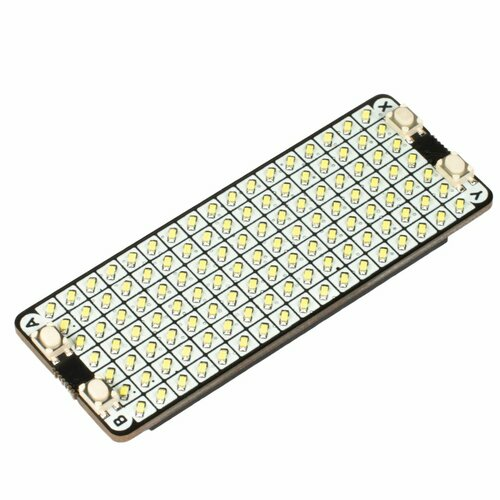Hey there! Stop scrolling and take a moment to admire the simple yet elegant bright white LEDs in the Pico Scroll Pack. These white LEDs, often overshadowed by flashy RGB ones, are arranged in a neat 7x17 matrix (that's 119 LEDs in total). There are also four tactile buttons for you to interact with your Pico-based device. Now, you can go back to scrolling!Each LED's brightness can be controlled individually. It's perfect for showing graphs, scrolling messages, creating soothing snowfall animations, or visualizing cellular automata. How cool is that?Note that a Raspberry Pi Pico isn't included. Click here if you want to buy one!Features:- 17x7 matrix of white LEDs (119 in total)- Individual PWM brightness control for each LED- IS31FL3731 LED matrix driver chip with I2C address: 0x74- 4 tactile buttons- Pre-soldered female headers for easy attachment to Pico- Compatible with Raspberry Pi Pico- Fully assembled- No soldering needed if your Pico has header pins- Dimensions: about 65mm x 25mm x 10mm (L x W x H, including headers and buttons)- Pinout- Programmable with C/C++ and MicroPythonGetting started:Look at the labels on the underside of the Pico Scroll Pack. They'll show you how to plug it into your Pico. Just match the USB port with the markings on the board.The easiest way to start programming our Pico add-ons is to download and copy our custom MicroPython image to your Pico. It has all the libraries you need!You can find our C/C++ and MicroPython libraries and code examples here.About Raspberry Pi Pico:The Raspberry Pi Pico is a versatile, low-cost microcontroller development board from Raspberry Pi, based on their RP2040 chip. It's easy to program over USB with C/C++ or MicroPython and great for all kinds of physical computing projects. We can't wait to see what you create!We call our Pico-sized add-ons 'packs' because they're designed to attach to the back of your Pico like a stylish backpack. We also have Pico 'bases' (larger add-on boards) and other boards for cool hacker stuff. Click here to see them all.Remember, your Pico needs male headers soldered to it (pins pointing downwards) to attach to our add-on boards.

Using the Pico Scroll Pack is a breeze. First, make sure your Raspberry Pi Pico has male headers soldered with the pins pointing downwards. Then, look at the labels on the underside of the Pico Scroll Pack and match the USB port with the markings on the board to plug it in correctly. To start programming, download and copy our custom MicroPython image to your Pico. It comes with all the necessary libraries. You can also find C/C++ and MicroPython libraries and code examples on our website.Once it's set up, you can use the four tactile buttons to interact with your Pico-based device. Each of the 119 white LEDs in the 7x17 matrix can have its brightness controlled individually. This allows you to display graphs, scrolling messages, create snowfall animations, or visualize cellular automata.As for maintenance, keep the Pico Scroll Pack in a clean and dry place. Avoid exposing it to extreme temperatures or humidity. If there's dust on it, you can gently wipe it with a soft, dry cloth. That's all you need to do to keep it in good working condition.







